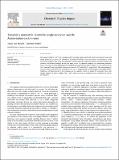Files in this item
Towards a symmetric reversible single-molecule switch : amino-imino-cyclo-n-enes
Item metadata
| dc.contributor.author | van Mourik, Tanja | |
| dc.contributor.author | Früchtl, Herbert | |
| dc.date.accessioned | 2021-09-02T07:30:12Z | |
| dc.date.available | 2021-09-02T07:30:12Z | |
| dc.date.issued | 2021-12 | |
| dc.identifier | 275626686 | |
| dc.identifier | a415bba2-176b-45b8-8ba1-5d6983d0a3a4 | |
| dc.identifier | 85126170022 | |
| dc.identifier | 000788112300008 | |
| dc.identifier.citation | van Mourik , T & Früchtl , H 2021 , ' Towards a symmetric reversible single-molecule switch : amino-imino-cyclo-n-enes ' , Chemical Physics Impact , vol. 3 , 100035 . https://doi.org/10.1016/j.chphi.2021.100035 | en |
| dc.identifier.issn | 2667-0224 | |
| dc.identifier.other | ORCID: /0000-0001-6647-4266/work/99465922 | |
| dc.identifier.other | ORCID: /0000-0001-7683-3293/work/99466001 | |
| dc.identifier.uri | https://hdl.handle.net/10023/23887 | |
| dc.description | The research data supporting this publication can be accessed at https://doi.org/10.17630/4908b94e-d478-4d1a-8f05-0d85851abab8. | en |
| dc.description.abstract | We propose cyclic 5- and 7-ring structures with alternating single and double bonds and adjacent imino and amino groups as candidates for switches in molecular electronics, with amino-imino tautomerisation as the switching mechanism. Due to the C2V-symmetric transition state, the molecules exhibit a symmetric double-well potential with identical energies for the two states, which is a desirable property for a functioning molecular switch. Calculations at the double hybrid mPW2PLYP-D2/def2-TZVP level show barriers of 1.07 and 0.52 eV for the 5-ring and 7-ring, respectively (zero-point corrected: 0.97 and 0.41 eV, respectively). The corresponding 9-ring structure is not suitable as a molecular switch, due to ring puckering and the existence of multiple minima. Attachment of ethyne groups to the nitrogens and the opposite carbon, as models for molecular wires, only slightly changes the barrier heights. The 5- and 7-ring structures are promising switch candidates for further investigation. | |
| dc.format.extent | 6 | |
| dc.format.extent | 2597096 | |
| dc.language.iso | eng | |
| dc.relation.ispartof | Chemical Physics Impact | en |
| dc.subject | Molecular switch | en |
| dc.subject | Molecular electronics | en |
| dc.subject | Aminotroponimine | en |
| dc.subject | Double hybrid density functional theory | en |
| dc.subject | QD Chemistry | en |
| dc.subject | DAS | en |
| dc.subject.lcc | QD | en |
| dc.title | Towards a symmetric reversible single-molecule switch : amino-imino-cyclo-n-enes | en |
| dc.type | Journal article | en |
| dc.contributor.institution | University of St Andrews. Centre for Research into Equality, Diversity & Inclusion | en |
| dc.contributor.institution | University of St Andrews. EaSTCHEM | en |
| dc.contributor.institution | University of St Andrews. School of Chemistry | en |
| dc.identifier.doi | https://doi.org/10.1016/j.chphi.2021.100035 | |
| dc.description.status | Peer reviewed | en |
This item appears in the following Collection(s)
Items in the St Andrews Research Repository are protected by copyright, with all rights reserved, unless otherwise indicated.

